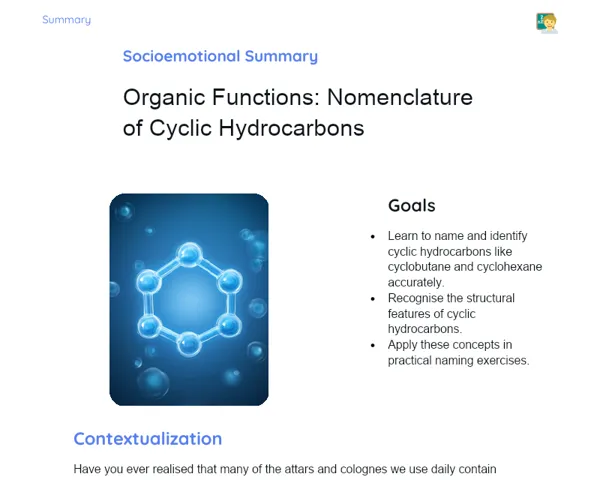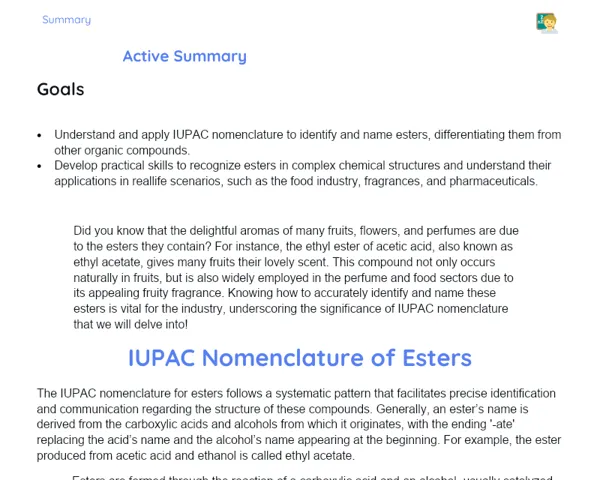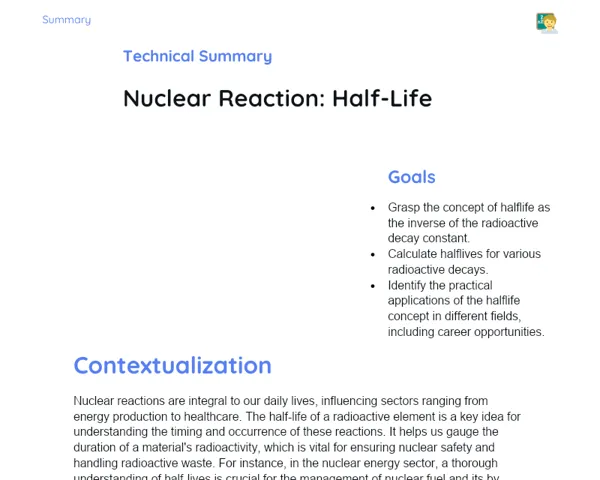Summary Tradisional | Mol: Amount of Substance
Contextualization
In chemistry, just like in many other fields of science, accurately measuring the amounts of substances is crucial. To help us with this, we use the concept of a mole, which is a unit that allows us to count particles like atoms, ions, and molecules practically. Similar to how we use a dozen to count eggs (1 dozen = 12 eggs), we use the mole to count particles (1 mole = 6.022 x 10^23 particles). This figure is famously known as Avogadro's Number.
Understanding the mole is vital for performing calculations in chemical reactions and grasping the composition of different substances. For instance, in the pharmaceutical industry, it's extremely important to ensure that the precise amounts of each compound are present in medications for them to be safe and effective. Moreover, the significance of the mole is such that October 23 is celebrated as Mole Day in honour of Avogadro's Number (6.022 x 10^23).
To Remember!
Concept of Mole
The mole is a key unit in chemistry used to measure the amount of matter. Just like we employ units such as the meter to measure length or the kilogram for mass, we utilize the mole to count particles. One mole is defined as the quantity of substance that contains exactly 6.022 x 10^23 elementary entities, such as atoms, ions, or molecules.
This quantity, referred to as Avogadro's Number, is a crucial constant in chemistry. It signifies the number of particles in a mole of any substance. This standard allows chemists to carry out accurate calculations involving the amounts of reactants and products in chemical reactions.
The mole serves as a bridge between the microscopic level (number of particles) and the macroscopic level (mass of a substance), which is essential for understanding and executing chemical reactions. Without the concept of the mole, it would be exceedingly challenging to quantify the materials involved in chemical processes effectively.
-
The mole is a unit of measure for the amount of matter.
-
1 mole equates to 6.022 x 10^23 particles (Avogadro's Number).
-
The mole aids in converting between particle numbers and the mass of a substance.
Avogadro's Number
Avogadro's Number, 6.022 x 10^23, is a constant that defines the number of particles in a mole of any substance. It was named after Italian scientist Amedeo Avogadro, who suggested that equal volumes of gases at the same temperature and pressure contain an equal number of particles.
This value is fundamental for chemistry as it allows scientists to switch between the mass of a substance and the number of particles it includes. For example, knowing that 1 mole of water (H2O) has a mass of 18 grams and contains 6.022 x 10^23 molecules enables us to perform precise calculations for chemical reactions involving water.
Avogadro's Number is equally important in other scientific domains, including physics and biology, where accurate particle counting is essential for diverse analyses and experiments.
-
Avogadro's Number is 6.022 x 10^23 particles per mole.
-
It facilitates conversion between mass and particle counts.
-
It is fundamental for calculations in chemical reactions as well as other scientific fields.
Calculations with Moles
To find the amount of matter in moles, we use the formula n = m/M, where n represents the number of moles, m is the substance's mass in grams, and M is the molar mass (the mass of 1 mole of the substance). Molar mass is obtained by adding the atomic masses of the elements in the compound, based on the periodic table.
For instance, to calculate how many moles are in 36 grams of water (H2O), we ascertain that the molar mass of water is 18 g/mol (2*1 for hydrogen + 16 for oxygen). Hence, n = 36 g / 18 g/mol = 2 moles. This calculation is vital for understanding the accurate proportions of reactants and products in a chemical reaction.
Additionally, we can utilize Avogadro's Number to transition between particle counts and the amount of matter in moles. If we know we have 1.2044 x 10^24 molecules of CO2, we can conclude that this corresponds to 2 moles of CO2, given the direct relationship with Avogadro's Number.
-
Formula for calculating moles: n = m/M.
-
The molar mass is the summation of the atomic masses of the elements comprising the substance.
-
Conversion between particle counts and moles can be executed using Avogadro's Number.
Applications of the Mole
The concept of the mole finds extensive practical applications in various branches of chemistry and industries. In the pharmaceutical realm, for instance, precision in the quantity of materials is critical for formulating medications. Each tablet must contain the exact dose of active substances to guarantee efficacy and safety.
In the food industry, the mole is employed to measure the concentration of ingredients and additives, bolstering product quality and safety. In research labs, the mole is essential for conducting accurate experiments, where the quantity of reactants and products has to be measured with precision.
Moreover, the mole is applicable in domains like molecular biology, where it is important for calculating the number of molecules of DNA or proteins within a sample. Thus, the mole is an invaluable tool for scientists and engineers across numerous disciplines, enabling the effective measurement and control of various substances.
-
The mole plays a crucial role in drug formulation within the pharmaceutical industry.
-
Used to measure concentrations of ingredients in the food sector.
-
Essential for precise experiments in research laboratories.
Key Terms
-
Mole: Unit of measure for the amount of matter, equivalent to 6.022 x 10^23 particles.
-
Avogadro's Number: Constant defining the number of particles in a mole, equal to 6.022 x 10^23.
-
Molar Mass: Mass of 1 mole of a substance, calculated by summing up the atomic masses of its elements.
-
Chemical Calculation: Mathematical methods used to determine quantities of reactants and products in chemical reactions.
Important Conclusions
The concept of the mole is fundamental in the realm of chemistry, allowing us to measure the quantity of matter in a substance accurately. We discovered that one mole corresponds to 6.022 x 10^23 particles, a constant referred to as Avogadro's Number. This unit is vital for transitioning between the microscopic and macroscopic levels, aiding calculations in chemical reactions.
We examined how to calculate the amount of matter in moles using the formula n = m/M, where n denotes the number of moles, m is the mass in grams, and M is the molar mass. Practical examples illustrated how we can apply these calculations in real-world situations, such as medication production and chemical compound analysis.
The relevance of the mole transcends academic settings, proving crucial in industries like pharmaceuticals and food. The application of the mole ensures accuracy and safety in product formulations, highlighting its practicality and impact on our everyday lives.
Study Tips
-
Review the basic concepts about moles and Avogadro's Number, using practical examples to bolster understanding.
-
Practice calculations using the formula n = m/M, as well as converting between particle counts and moles to enhance comprehension.
-
Explore the applications of the mole in various industries, such as pharmaceuticals and food, to appreciate the topic's relevance in real contexts.



